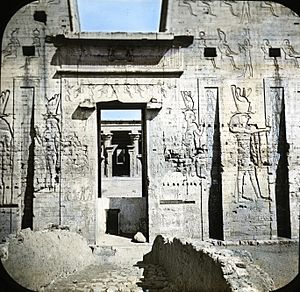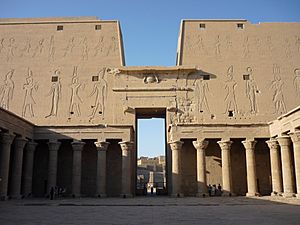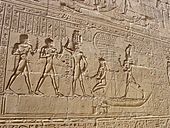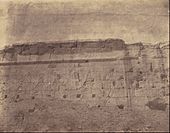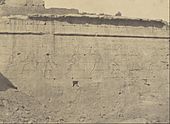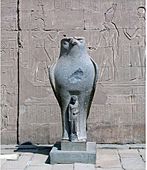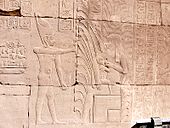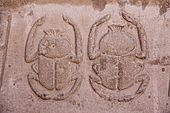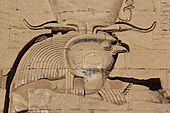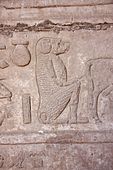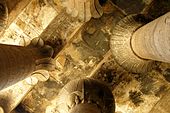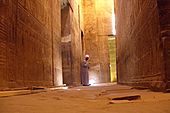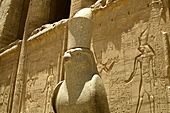Temple of Edfu facts for kids
| Temple of Edfu | ||||
 The main entrance of Edfu Temple showing the first pylon |
||||
Quick facts for kids Monument Information |
||||
|---|---|---|---|---|
| Type | Temple | |||
| Location | Egypt | |||
| Ancient Egyptian Region | Wetjes-Hor | |||
| Ancient Egyptian Name |
(Bḥd.t) |
|||
| Main Gods | Horus (primary), Hathor, Harsomtus | |||
| Historical Information | ||||
| Period | Graeco-Roman Period | |||
| Dynasty | Ptolemaic dynasty | |||
| Construction Start Date | August 23, 237 BC | |||
| Completion Date | 57 BC | |||
| Architectural Description | ||||
| Construction Material | Sandstone | |||
| Height | 36 meters | |||
| Width | 76 meters | |||
| Length | 79 meters | |||
The Temple of Edfu is an Egyptian temple located on the west bank of the Nile River in Edfu, Upper Egypt. The city was known in ancient Greek times as Apollonopolis Magna. This name came from the main god Horus, who was seen as similar to the Greek god Apollo.
This temple is one of the best-preserved ancient shrines in all of Egypt. It was built during the Ptolemaic Kingdom between 237 BC and 57 BC. The carvings and writings on its walls tell us a lot about the language, myths, and religion of Egypt during this time. They even explain how the temple was built and how ancient Egyptians thought of temples as "Islands of Creation." The walls also show important scenes about the old conflict between the gods Horus and Seth.
Contents
History of the Temple of Edfu
The Temple of Edfu was one of several temples built when the Ptolemaic Kingdom ruled Egypt. Other temples from this time include the Dendera Temple complex, Esna, the Temple of Kom Ombo, and Philae. The large size of the Edfu temple shows how wealthy Egypt was during that period.
Construction of the current temple began on August 23, 237 BC. It first included a hall with many columns, two other halls, and a special room for a sacred boat, surrounded by smaller chapels. The building work started under King Ptolemy III Euergetes and was finished in 57 BC by King Ptolemy XII Auletes.
The new temple was built on the site of an older, smaller temple. That older temple was also dedicated to Horus. However, the old temple faced east-west, while the new one faces north-south. There are still remains of an older pylon, which is a large gateway, just east of the current temple. Writings found there show that kings like Ramesses I, Seti I, and Ramesses II from the New Kingdom of Egypt had built structures there before.
Inside the most sacred part of the temple, called the inner sanctuary, there is a special stone shrine from an even older building. This shrine belonged to King Nectanebo II. The temple's main sacred boat room is surrounded by nine smaller chapels.
Later Years and Rediscovery
The Temple of Edfu stopped being used for religious ceremonies around 391 AD. This happened after the Roman Emperor Theodosius I made laws against non-Christian worship across the Roman Empire. Like many other ancient temples, many of Edfu's carved images were damaged by early Christians in Egypt. The blackened ceiling in the main hall, which you can still see today, is believed to be from a fire set to destroy what was then considered pagan religious art.
Over many centuries, the temple became buried deep under desert sand and mud from the Nile River. It was buried up to 12 meters (39 feet) deep! Local people even built their homes right on top of the buried temple grounds. By 1798, when a French expedition found the temple, only the very top parts of the large gateways were visible.
In 1860, a French expert on ancient Egypt named Auguste Mariette began the important work of digging the Edfu temple out of the sand.
Today, the Temple of Edfu is almost completely intact. It is a fantastic example of an ancient Egyptian temple. Because it is so well-preserved and important for history, it is a popular place for tourism in Egypt. Many riverboats that travel the Nile River stop here. In 2005, the area around the temple was improved with a visitor center and a paved parking lot. In 2006, a special lighting system was added so people could visit the temple at night.
Religious Importance
The Temple of Edfu is the largest temple dedicated to the gods Horus and Hathor of Dendera. It was a very important place for several festivals honoring Horus. Each year, the goddess Hathor would travel south from her temple at Denderah to visit Horus at Edfu. This event, which celebrated their sacred marriage, was a huge festival and pilgrimage for ancient Egyptians.
The Temple's Creation Story
The Temple of Edfu's walls tell a special creation story through many carvings and writings. These scenes are mostly found on the inside of the temple's outer walls.
The story describes the beginning of the world, when everything was covered by water. As land began to rise from the water, reeds started to grow. A falcon, which was the god Horus, landed among these reeds. A powerful bird then came and fed Horus, the lord of Edfu. This event was the start of the religious practices at Edfu.
A giant snake-like creature named Apophis tried to stop the creation of the world. Horus was scared, but a harpoon, which was a form of the god Ptah, came to help. The enemy was defeated, and creation continued. A falcon then formed the sky, with its wings stretching across the horizon, and the sun began its daily journey.
After this, the first temple of Edfu was designed by the gods Thoth and Seshat. Thoth was the god of wisdom, and Seshat was the goddess of writing. A divine master-builder then constructed the temple following their plans. At first, it was made of reeds, not stone.
The ceremony for starting the temple's construction involved several steps. First, the ground plan was carefully marked out using a "stretching-the-cord" ritual. Once the temple was finished, the king officially gave it to a group of three main gods. To protect the building from dangers, 60 gods formed a living wall around the temple.
Influence on Architecture
The Temple of Edfu inspired the design of a building called Temple Works in Holbeck, Leeds, England. The columns in the courtyard of Edfu temple were closely copied in the front of the Temple Works building.
Gallery
-
1854 photography by John Beasley Greene
-
Wadjet and Nekhbet, the Two Ladies (goddesses representing Upper and Lower Egypt) next to the pharaoh
See also
 In Spanish: Templo de Edfu para niños
In Spanish: Templo de Edfu para niños
- List of ancient Egyptian sites, including places with temples
- Ancient Egyptian architecture
- Edfu South Pyramid



